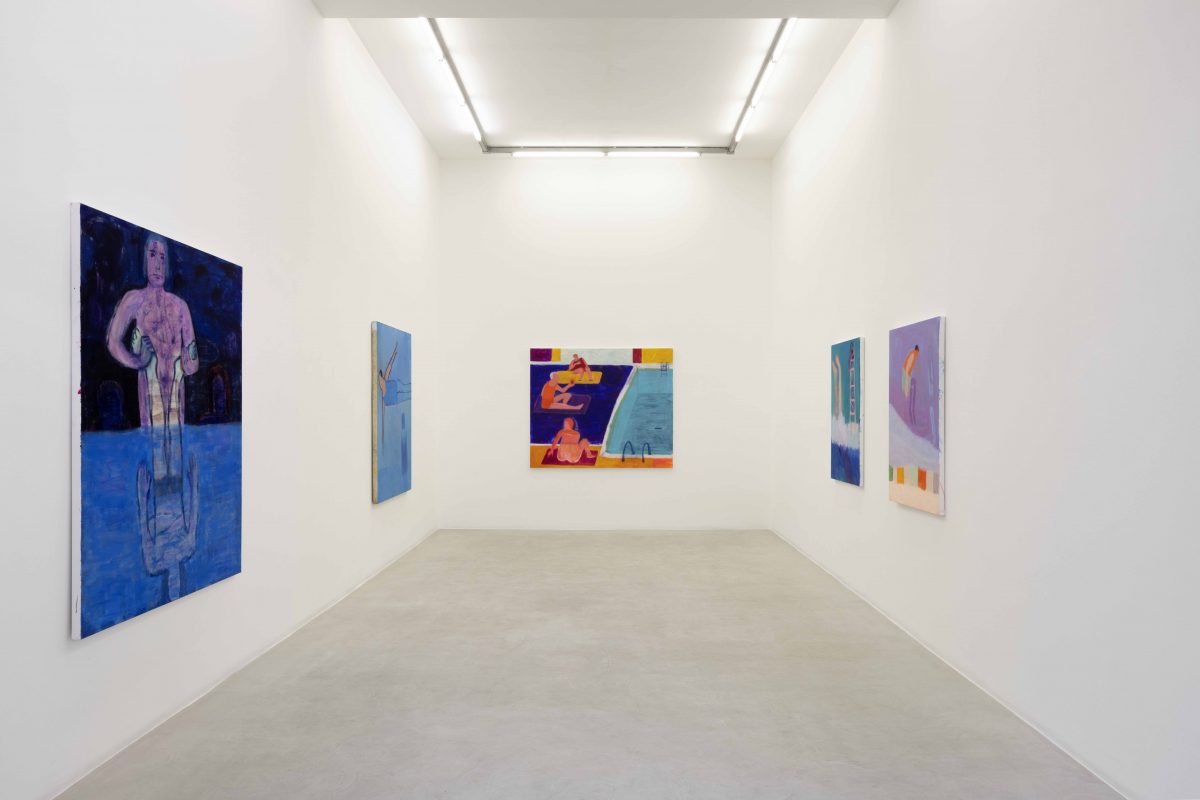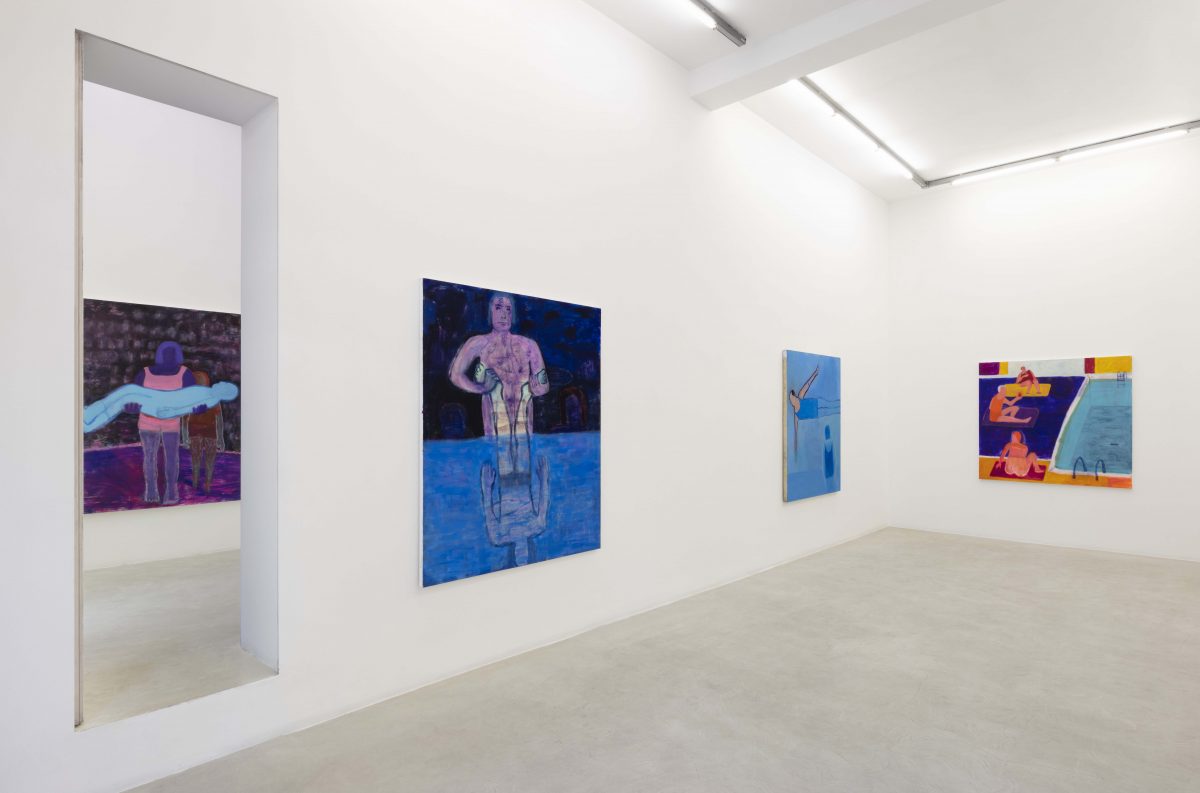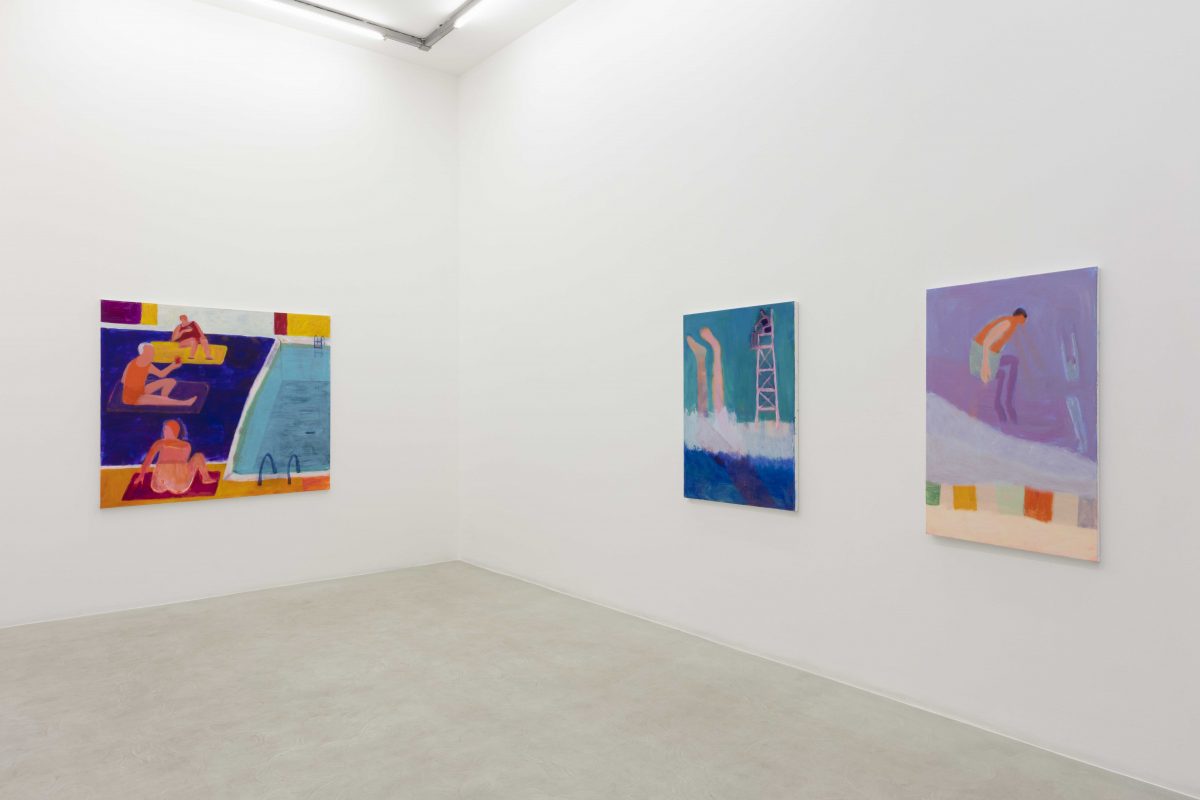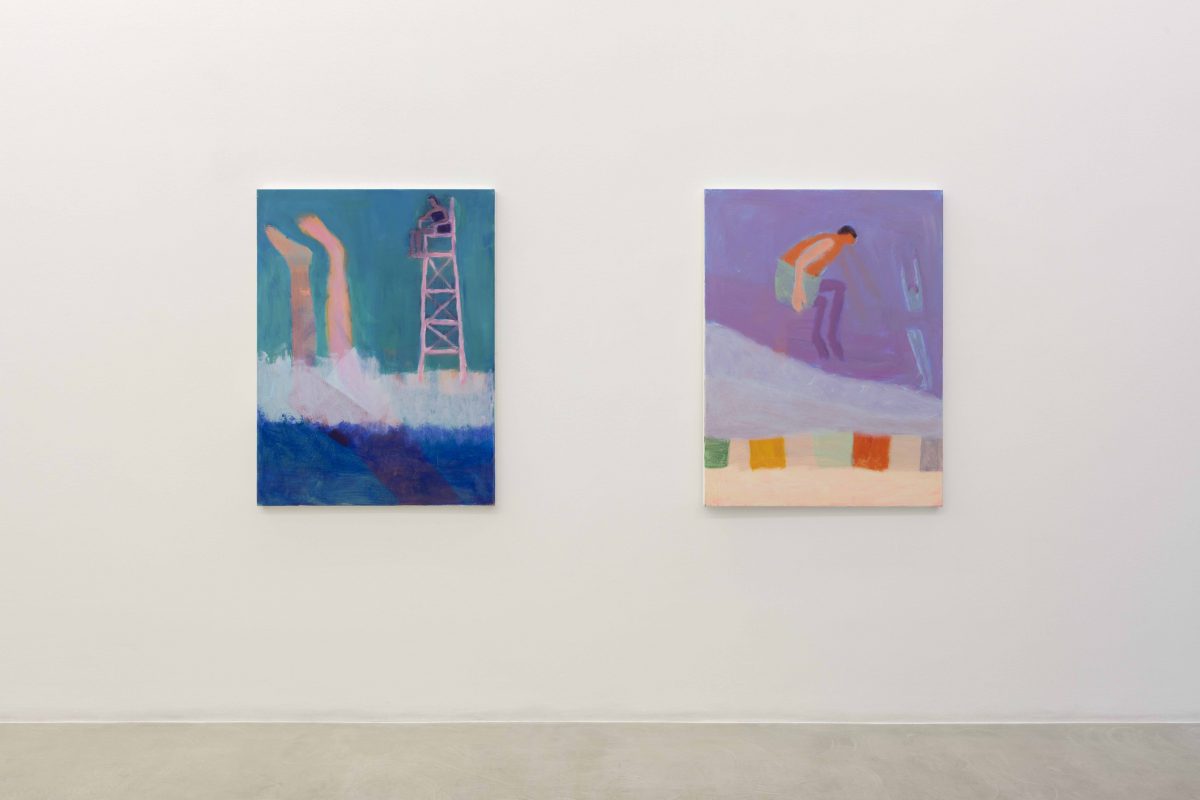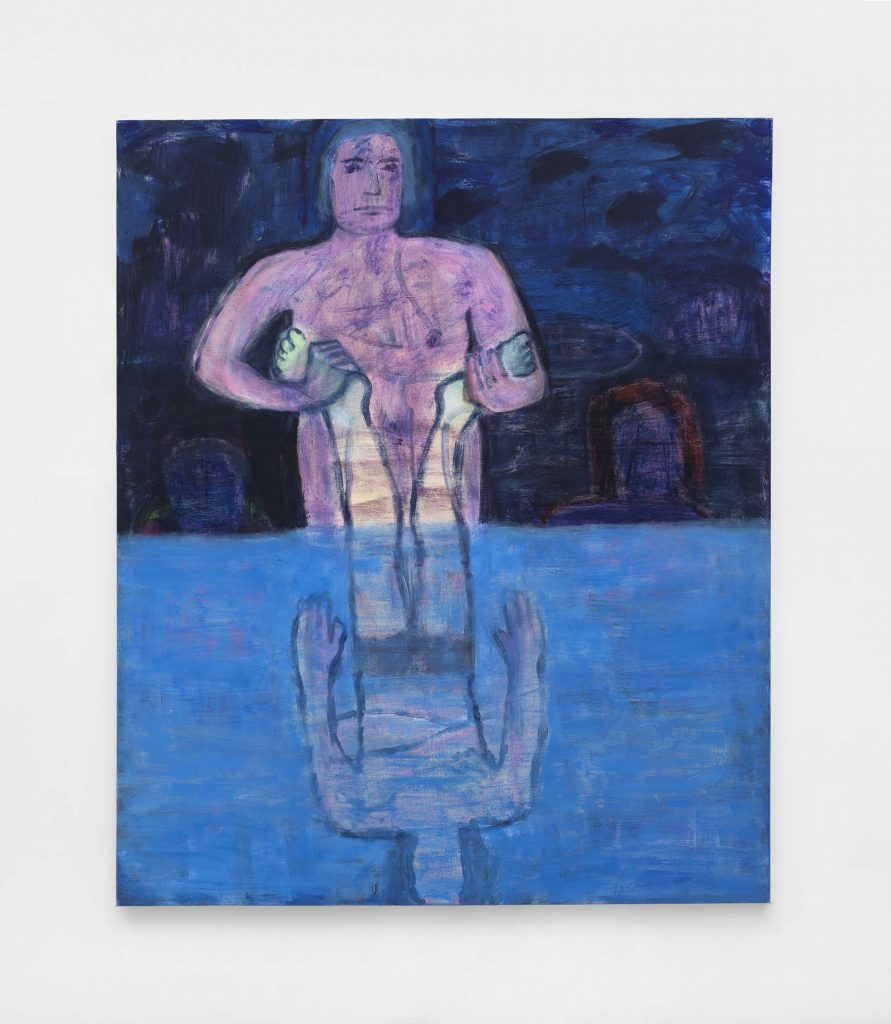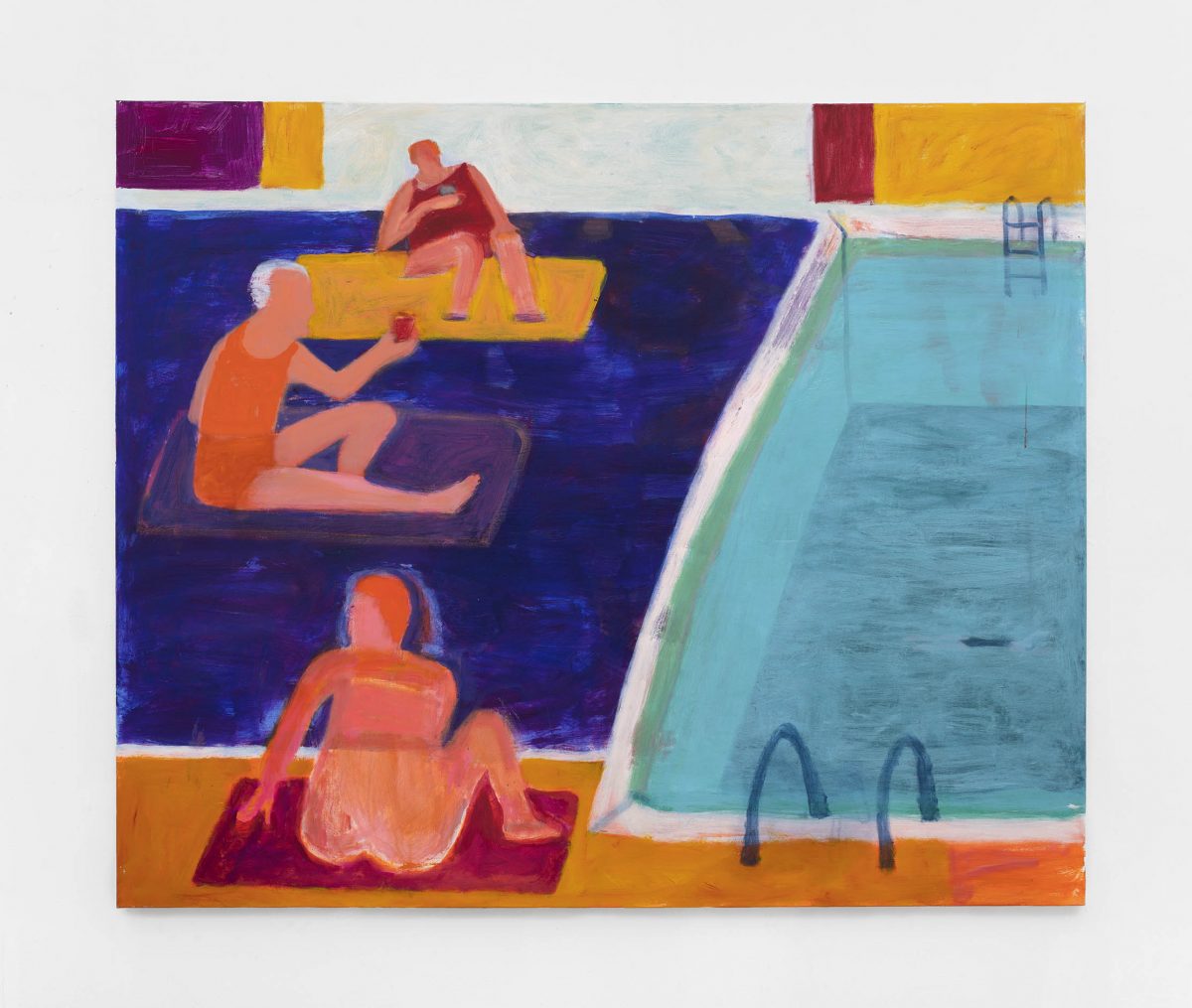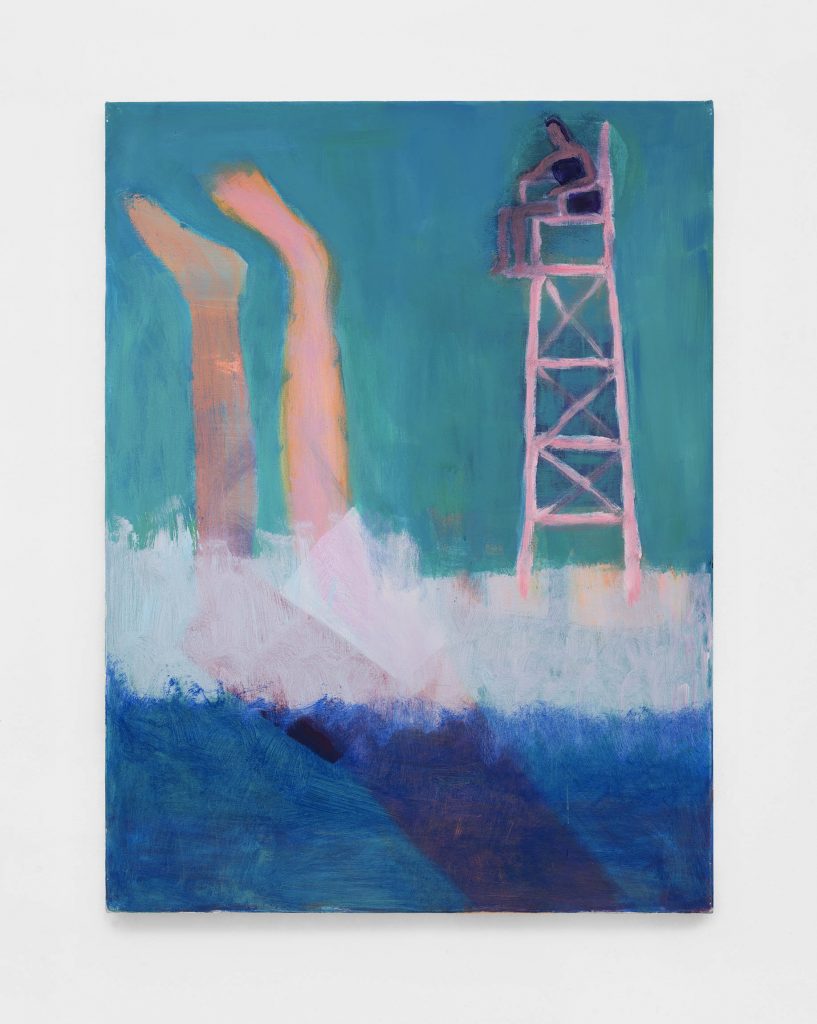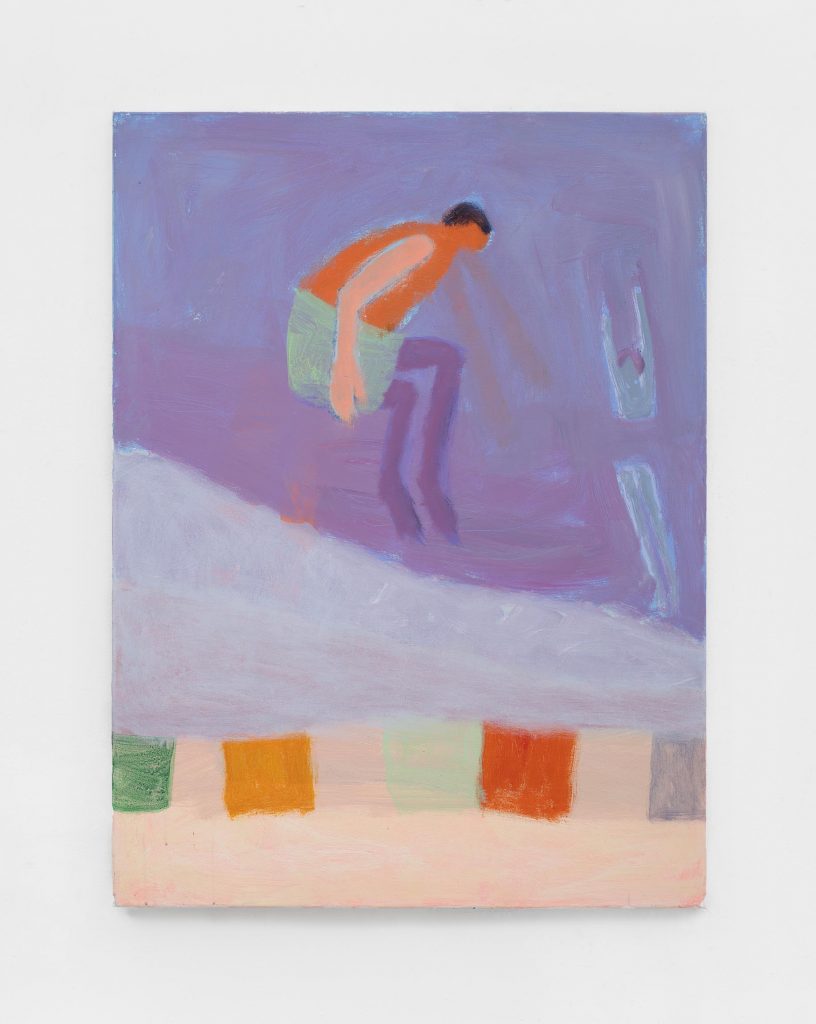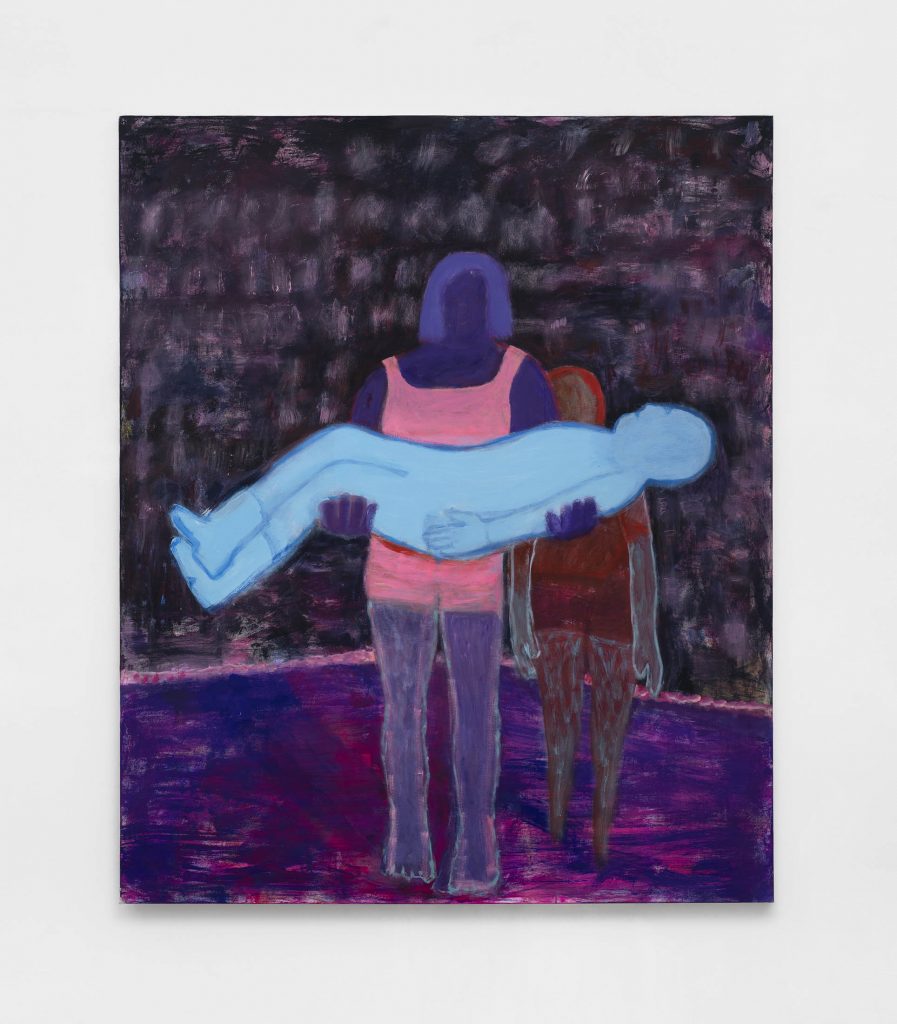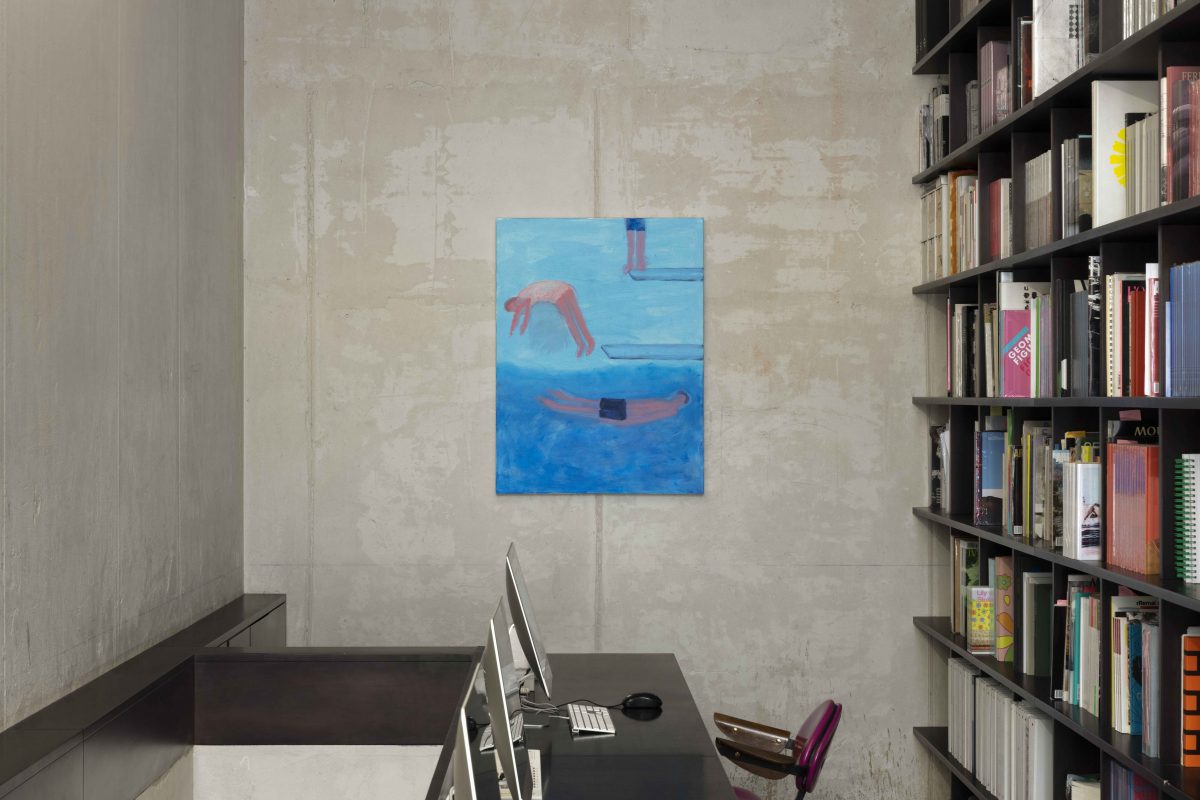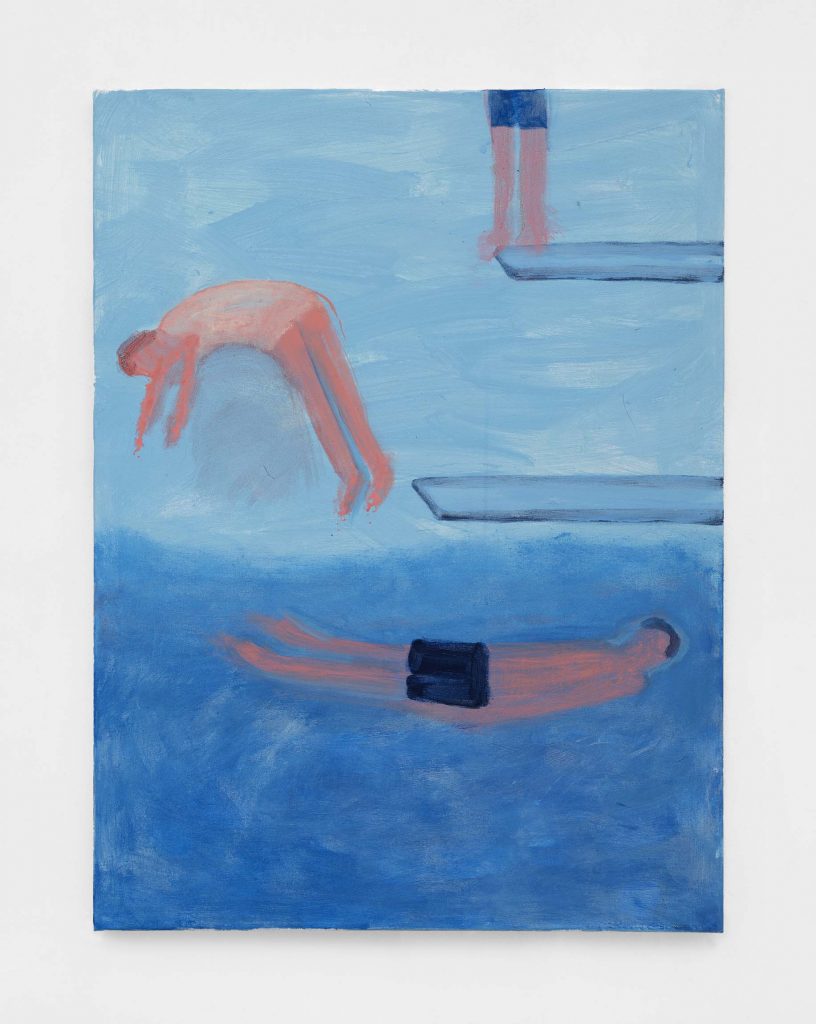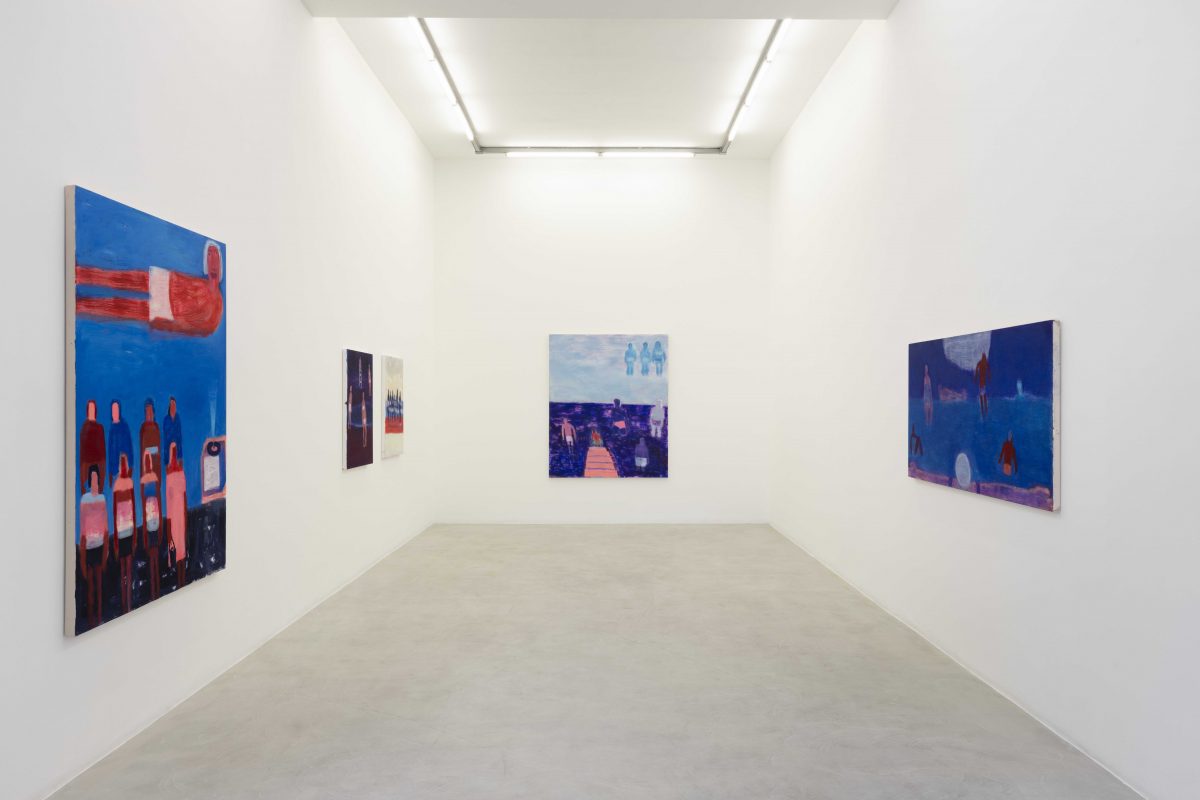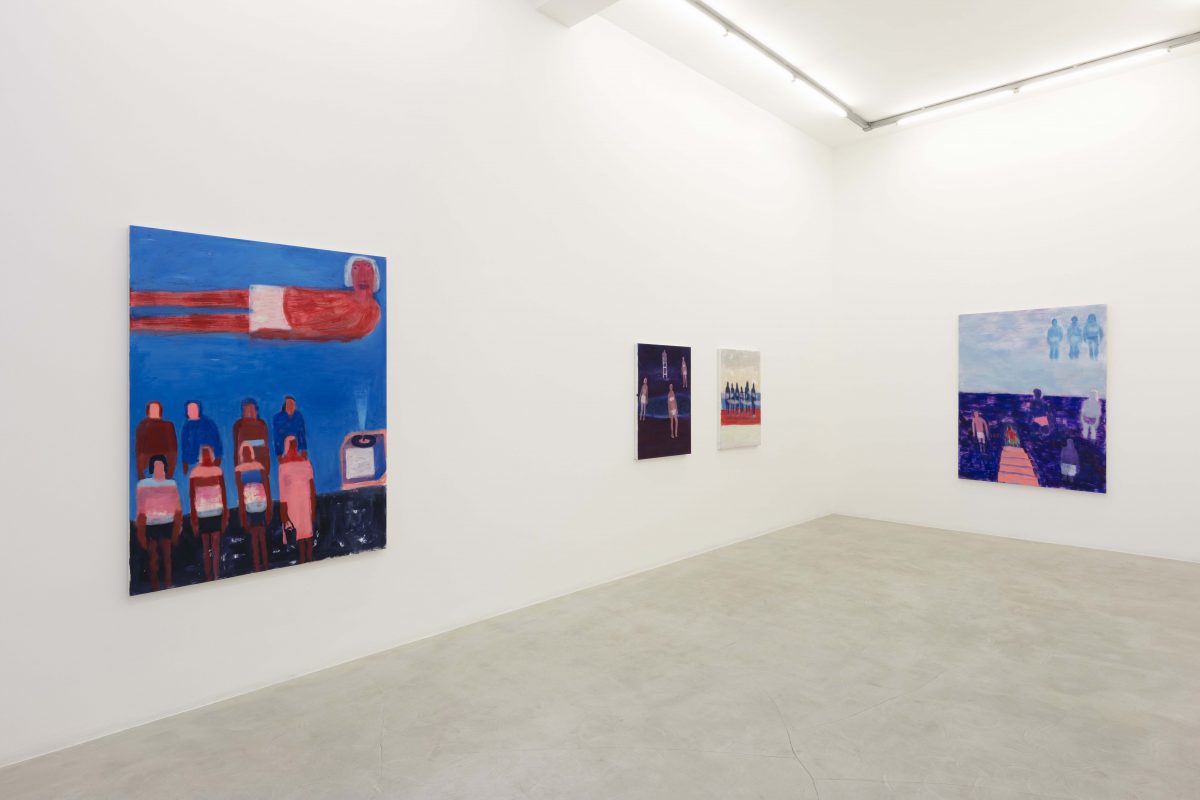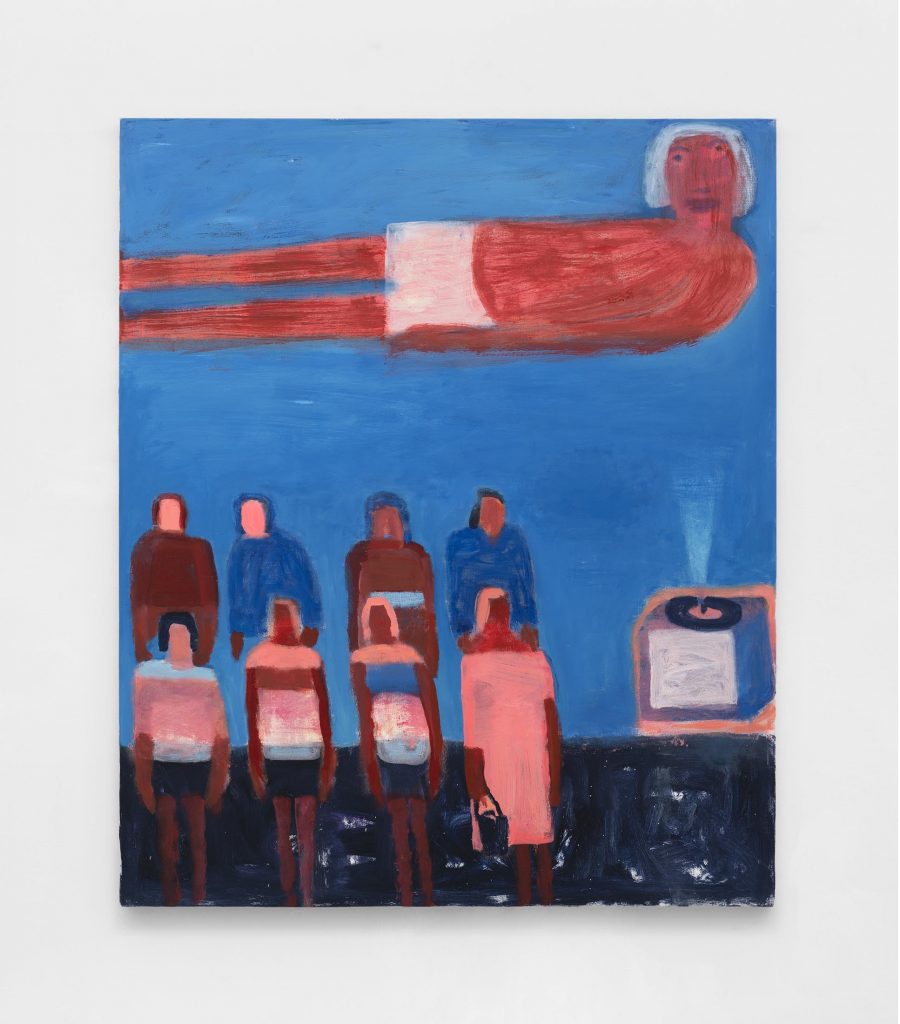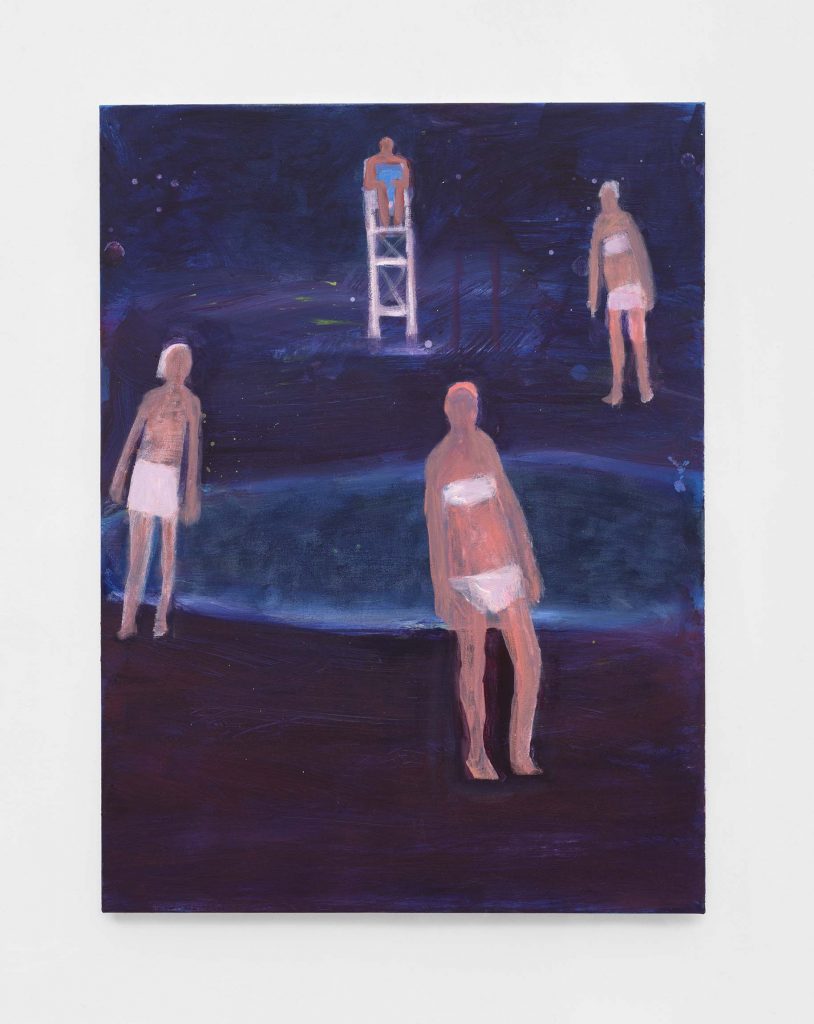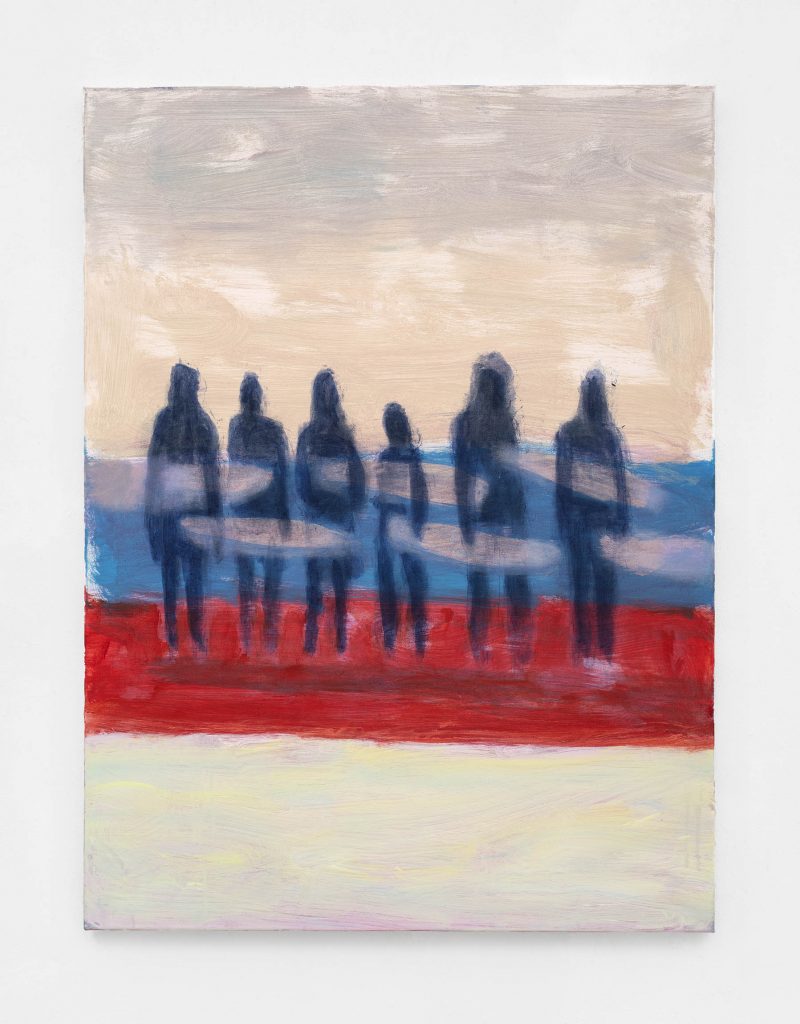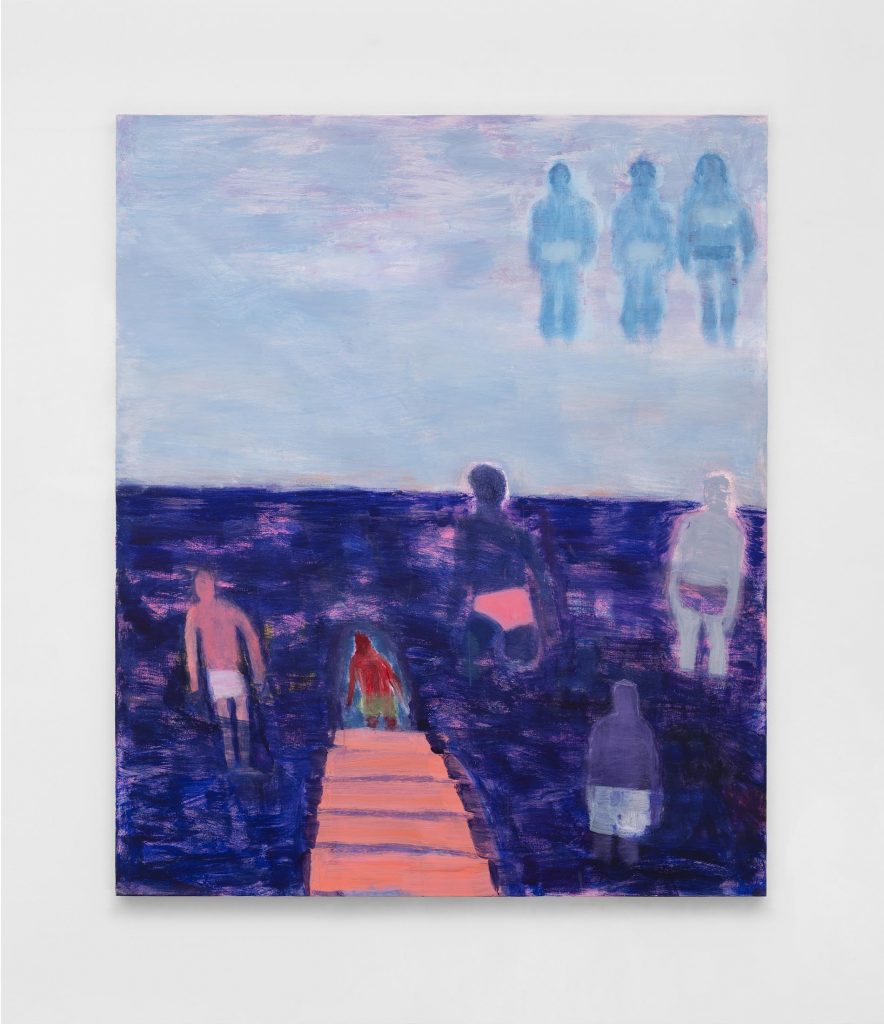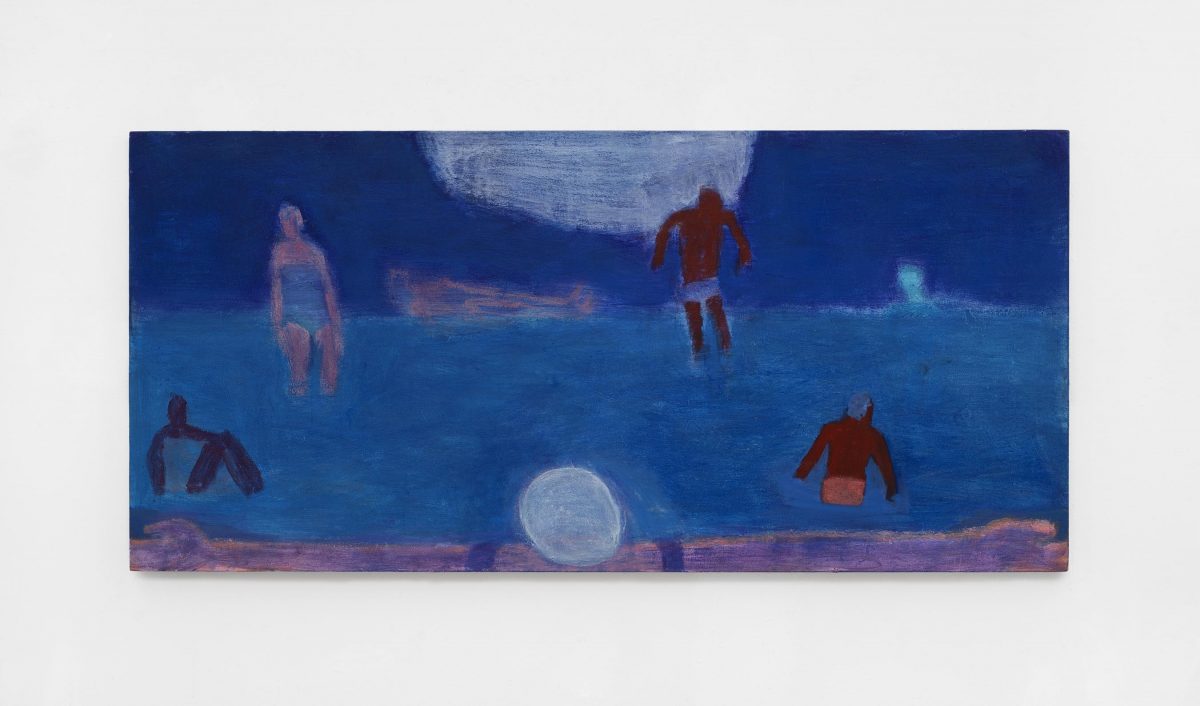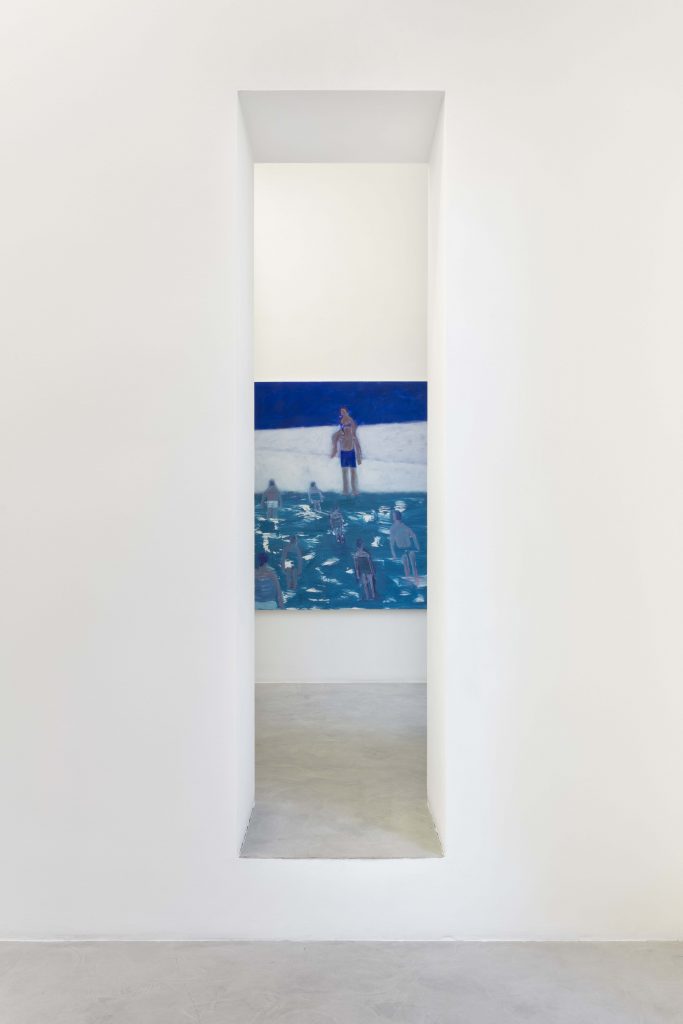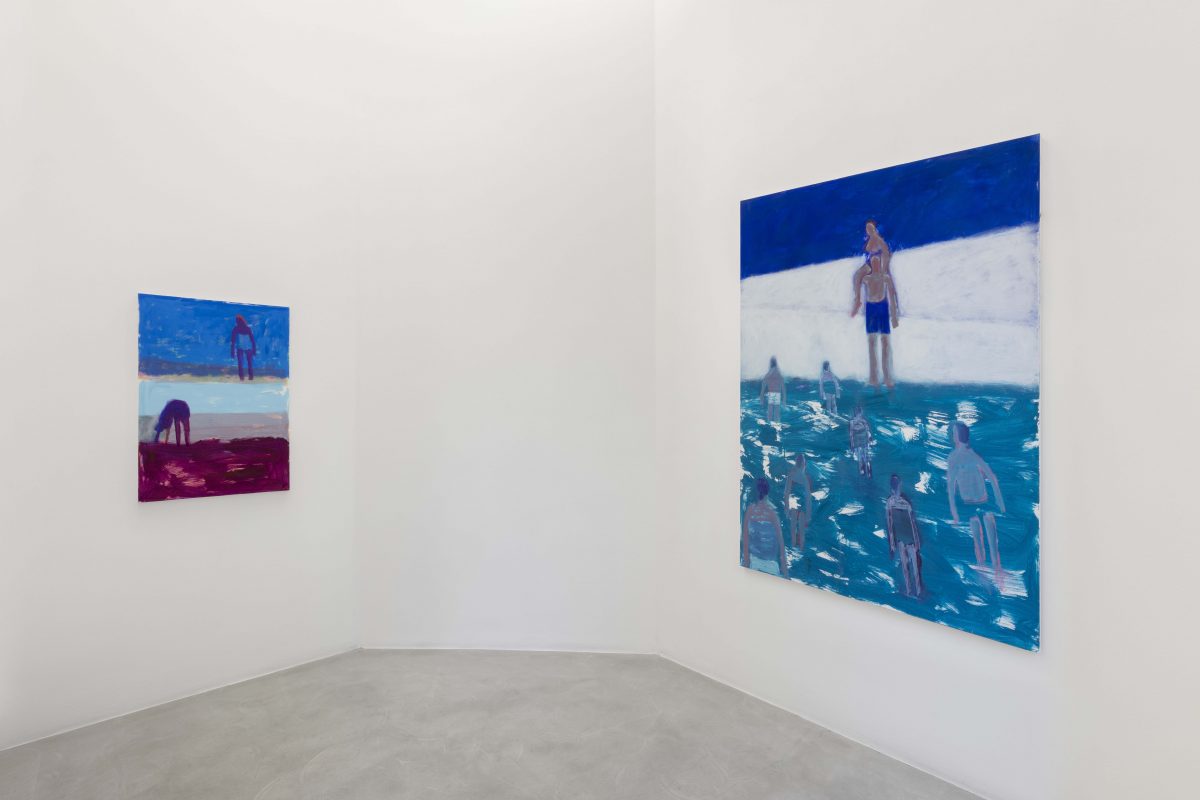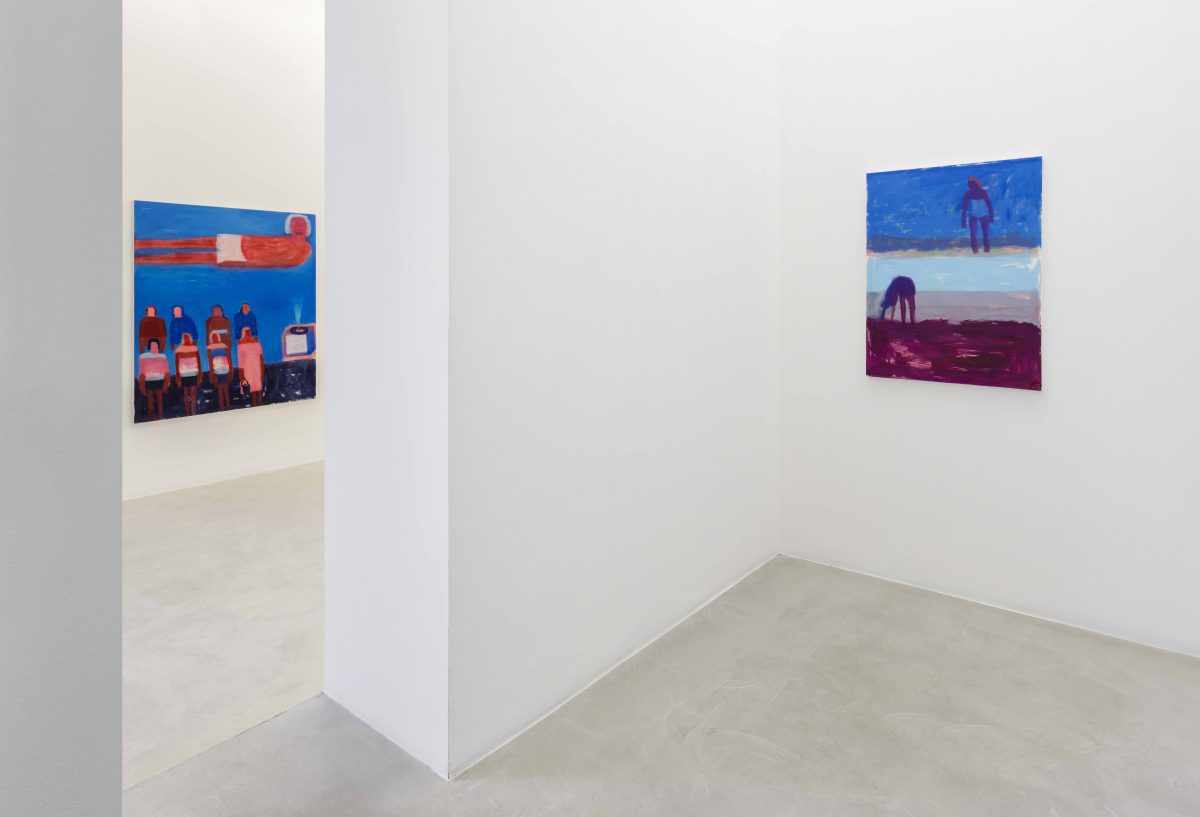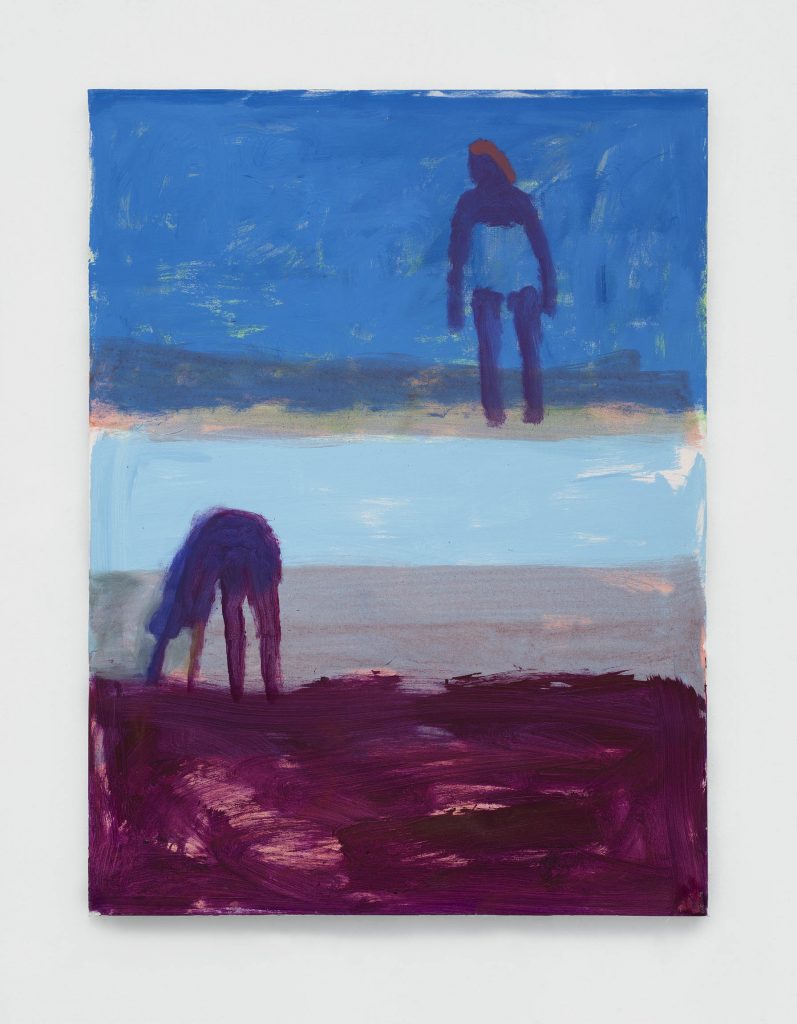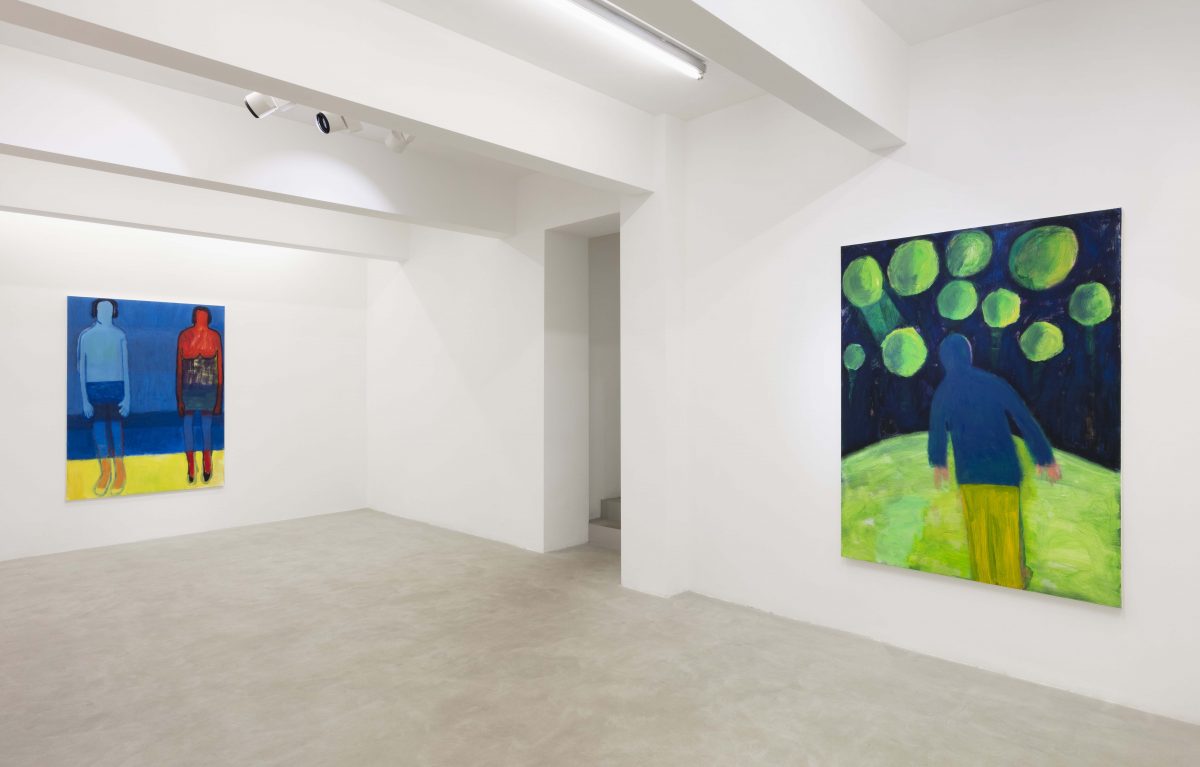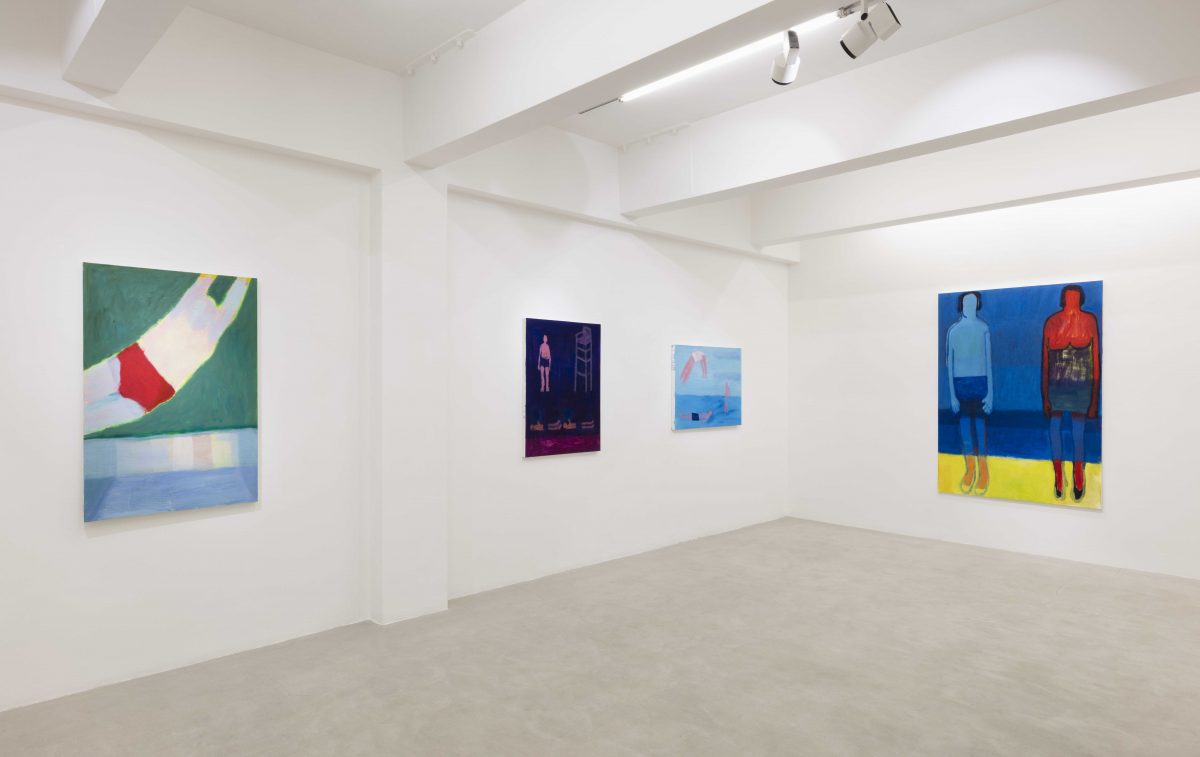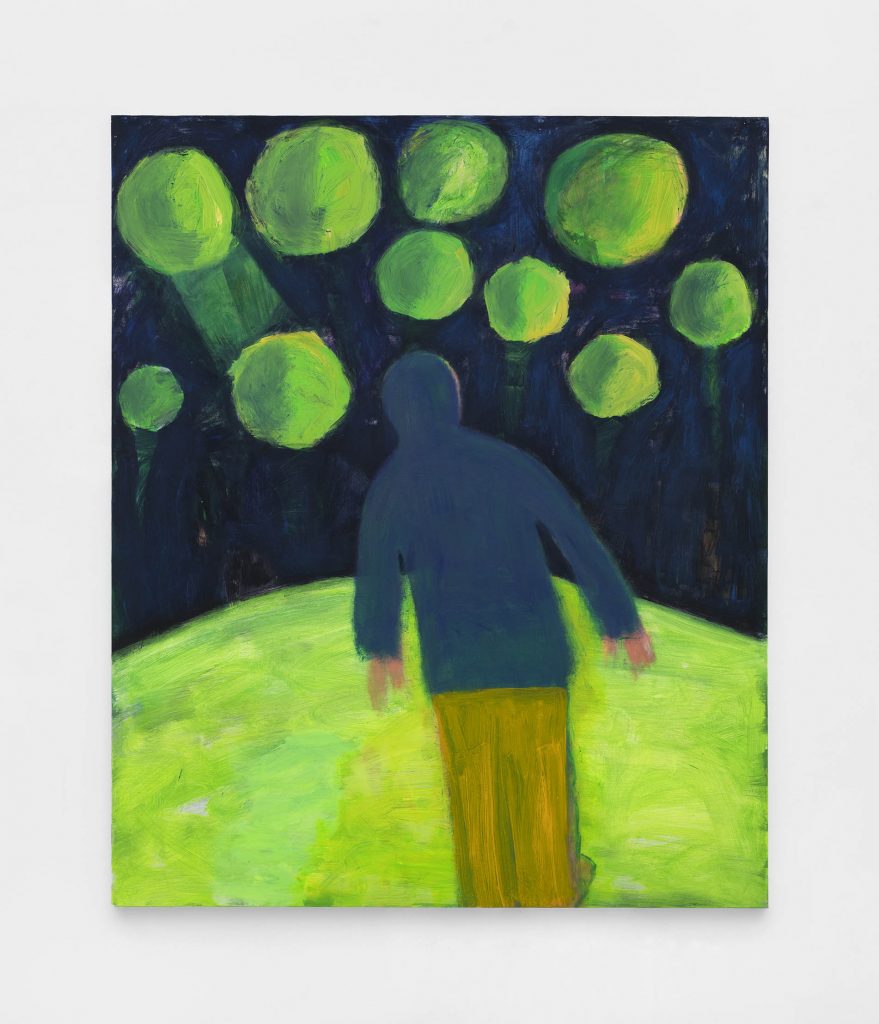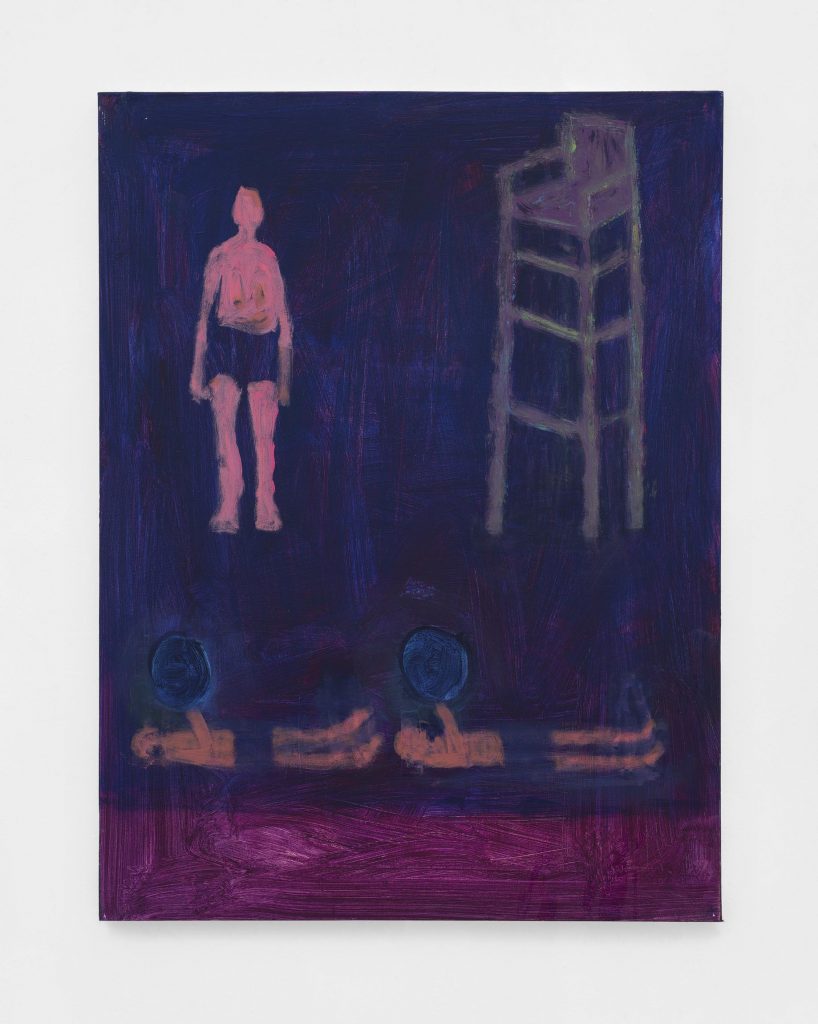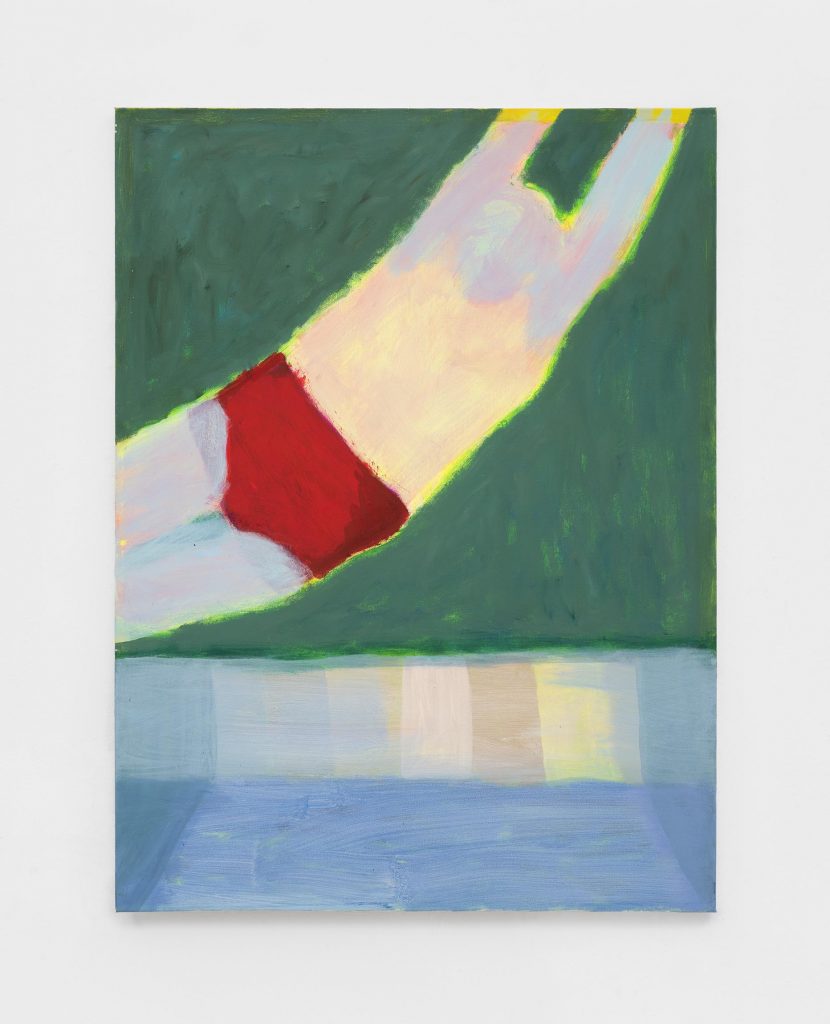
- This event has passed.
kaufmann repetto is happy to present Lifeguards, Katherine Bradford’s first solo exhibition with the gallery.
Katherine Bradford’s mesmerizing yet rigorous visual language freely traverses the relationship between nonobjective and representational painting, allowing potential narratives to unfold and interweave with the investigation of form and color.
In Bradford’s exhibition, Lifeguards, we find ourselves immersed in a world of vast expanses of color depicting water and sky, populated by bathers and swimmers. Shades of blue ranging from cobalt to azure, and ultramarine to turquoise, divide the canvas into distinct horizontal planes, while the variations in saturation and tone evoke an elusive yet palpable atmosphere. Lighter and darker hues are interchangeable and used without functional or hierarchical distinction. Subtle modulations of pale lavender and warm purple represent beaches, to then resurface in other works depicting body limbs. An indigo-blue firmament merges into an equally saturated body of sapphire-colored water, as if the two elements were soaking into each other by mutual consent. The compositional strategy is diversified; some paintings are limited to two dominating color fields, while in others the presence of red, white or yellow stripes introduces additional spatial elements such as the seafloor or the pool deck. These nearly monochromatic backgrounds are occupied by an array of swimmers who float in the air or plunge into the water, while others are gathered ashore. Their androgynous, featureless bodies are roughly sketched in bold colors representing their sun-tanned skins, which vary from pale rosy to pink, from glowing salmon to cool purple. Often the positions of these figures are fantastical and absurd, an effect reinforced by erratic manipulations of the pictorial perspective. We encounter two swimmers hovering majestically in horizontal expanses of washy blue in the upper half of the canvas; others are captured in the moment of jumping, head first, into the water, immortalized in awkward angular body postures. In contrast to these whimsical—almost funny—poses, the lifeguards who give the show its title, are sitting on or standing next to their towers, whose three-dimensional verticality interrupts the otherwise predominantly flat image compositions. Two guards are depicted while performing life-saving measures: a man is pulling a swimmer out of the water, grasping him vigorously by the legs, while a female lifeguard carries the body of a rescued person—a motionless silhouette of unnatural bluish pallor— in her arms. Art historical references are strongly resonant in these figure groups, evoking biblical subject matters such as Saint John the Baptist and the Pietà. Further, the dual nature of the title of the show, “life” and “guard”, is literal in these works, alluding to the lifeguard’s task of taking care of other human beings, or the lifeguard as savior.
While the oscillation between abstract and figurative elements captures and ensnares the viewer, giving way to multiple readings, it is also a key to the wider scope of Bradford’s artistic research. Focused on abstract painting in the early phase of her career, over the past two decades the artist has opened her practice to depiction, without losing focus on her abiding interest in the [more abstract nature] of the color-field. Her love for the painterly comes across clearly; however, driven by an unbiased curiosity, she allows her imagery to acquire a porous malleability where a pictorial sign becomes a signifier. The first brusquely painted marks that manifested themselves as objects within the realm of colors were ships, planets and UFOs. Human beings floating in horizontal position, in the guise of gravity-defying superheroes and swimmers, soon appeared on the scene: suspended in the fathomless depth of oceans and starry nights, these quirky characters seem to oscillate between unrestrained freedom and melancholic solipsism. Over the past couple of years, the weight of the harsh political situation and, lately, the impact of the Covid pandemic, prompted the artist to deepen themes of social relations among human beings, a concern that also reflects her long-standing commitment to artists’ communities in New York and Maine. The investigation of more complex figure groups is at the center of her most recent bodies of work, with Mother, the exhibition at Canada Gallery in New York, and the current Lifeguards show in Milano. “I’m doing people, but I’m really emphasizing a universality”, says the artist, “I feel that’s important, that I’m exploring who we are, how we fit in, how we fit in together visually, how we all stand next to each other.”
Insouciant vis-à-vis the formal constraints of cultural production for a long part of her career, Bradford has honed her practice over four decades, maturing into a nonacademic, creative freedom that resonates deeply with the aesthetic and socio-political concerns of our time. Her position seems to epitomize the “liquid modernity” theorized by the sociologist Zygmunt Bauman, who advocates that after the dissolution of the ‘solid’ axioms of modernism—such as rationality and the chase of perfection—we have arrived in a more ‘light’ and ‘liquid’ modernity, where “change is the only permanence, and uncertainty the only certainty”. It is the commitment to dynamic change and to the fluid state of human togetherness that Bradford—with a small wink and a large dose of humor—so poignantly expresses in her radiant liquid fields.
Katherine Bradford (b. 1942, New York) lives and works in New York. She started painting at the age of 30 while living in Maine and was among a group of artists who moved to Williamsburg, Brooklyn in the 1980’s. Her work has been exhibited internationally at the Tang Teaching Museum, Skidmore College, New York (2020); Crystal Bridges Museum of American Art, in Bentonville (2019); The Brooklyn Museum, New York; the Modern Art Museum in Fort Worth, Texas (2017); MoMA P.S. 1 (2007) and at the Ogden Museum in Prospect.4: the New Orleans Biennial. Her work is included in collections such as The Metropolitan Museum of Art, The Brooklyn Museum, The Dallas Museum of Art, The Menil Collection in Houston, The Nerman Museum of Contemporary Art in Overland Park and the Portland Museum of Art. Bradford is the recipient of a Guggenheim Fellowship and a Joan Mitchell Grant. She has taught at institutions such as the Yale School of Art, Skowhegan School of Painting and Sculpture, and the Pennsylvania Academy of the Fine Arts, Philadelphia. In 2022, Bradford will be the subject of a touring survey show organized by the Portland Museum of Art, Maine.
kaufmann repetto è lieta di presentare Lifeguards, la prima personale di Katherine Bradford con la galleria.
Ipnotico e al contempo rigoroso, il linguaggio visivo di Katherine Bradford si muove liberamente attraverso il confine fra pittura non oggettiva e figurativa, rivelando narrazioni potenziali che si intrecciano all’indagine di forma e colore.
Nella mostra Lifeguards ci troviamo immersi in un mondo composto da ampie campiture di colore che rappresentano cielo e distese d’acqua, popolati da bagnanti e nuotatori. Sfumature di blu che spaziano dal cobalto all’azzurro, e dall’oltremare al turchese, suddividono la tela in piani orizzontali ben definiti, mentre le variazioni di saturazione e tono evocano un’atmosfera sfuggente e insieme tangibile. Le tonalità più chiare e più scure sono intercambiabili, e utilizzate senza una distinzione funzionale o gerarchica. Delicate modulazioni del lavanda chiaro e del viola intenso rappresentano le spiagge, e riaffiorano in altre opere per raffigurare parti del corpo. Un firmamento color indaco si fonde in uno specchio d’acqua zaffiro, altrettanto saturato, come se i due elementi si compenetrassero di comune accordo. La strategia compositiva è variegata: alcuni dipinti si limitano a due campiture dominanti, in altri la presenza di strisce rosse, bianche o gialle introducono ulteriori elementi spaziali come il fondale marino o il bordo di una piscina. Questi sfondi quasi monocromatici sono occupati da numerosi nuotatori sospesi in aria o intenti a tuffarsi, mentre altri sono riuniti a riva. I loro corpi androgini e privi di lineamenti sono abbozzati con colori audaci che ne rappresentano la pelle abbronzata, tinta di rosa pallido o intenso, di salmone o viola acceso. Spesso assumono posizioni fantastiche e assurde, effetto amplificato dalle manipolazioni imprevedibili della prospettiva pittorica. Nella metà superiore della tela incontriamo due nuotatori che fluttuano maestosi sopra distese orizzontali di azzurro slavato; altri sono bloccati nel momento del tuffo, di testa, e immortalati in angolazioni bizzarre. In contrasto con tali pose stravaganti, quasi buffe, i bagnini che danno il titolo alla mostra sono seduti o in piedi accanto alle torrette, la cui verticalità tridimensionale spezza le composizioni predominanti. Due bagnini sono impegnati in misure di salvataggio: l’uomo tira fuori dall’acqua un nuotatore, afferrandolo con forza dalle gambe, mentre la donna stringe fra le braccia il corpo di una persona appena soccorsa, una silhouette immobile dall’innaturale pallore bluastro. In questi gruppi di figure sono evidenti i rimandi alla storia dell’arte, che evocano soggetti biblici come Giovanni Battista e la Pietà. La natura duplice del titolo della mostra, “life” (“vita”) e “guard” (“guardia”, “guardiano”), inoltre, emerge in modo letterale in questi quadri, che alludono al compito del bagnino che sorveglia altri esseri umani o al suo ruolo di “salvatore”.
Se l’oscillazione fra elementi astratti e figurativi cattura e intrappola lo spettatore offrendo molteplici interpretazioni, è anche una chiave per comprendere la portata più ampia della ricerca artistica di Bradford. L’artista, che nella prima fase della sua carriera si è concentrata sulla pittura astratta, da vent’anni ha aperto la propria pratica alla figurazione, senza però dimenticare il profondo interesse per [la natura più astratta dei] campi di colore. Il suo amore per il pittorico emerge con chiarezza; tuttavia Bradford, guidata da una curiosità imparziale, lascia che il suo immaginario acquisisca una malleabilità porosa in cui un segno pittorico diventa un significante. Le prime tracce, dipinte bruscamente, che si sono manifestate come oggetti nell’universo del colore erano navi, pianeti e ufo. Esseri umani che fluttuavano in posizione orizzontale, sotto forma di supereroi e nuotatori che sfidavano la gravità, sono comparsi sulla scena poco dopo: sospesi sulle profondità insondabili di oceani e cieli stellati, questi personaggi peculiari sembrano dividersi tra una libertà assoluta e un solipsismo malinconico. Negli ultimi anni, il peso della difficile situazione politica e, più di recente, l’impatto della pandemia causata dal Covid hanno spinto l’artista ad approfondire tematiche legate ai rapporti sociali fra esseri umani, interesse che riflette inoltre il suo impegno di lunga data verso le comunità artistiche a New York e nel Maine. L’indagine di gruppi di figure più complessi è al centro delle sue opere più recenti, esposte nella mostra Mother alla Canada Gallery di New York e nell’attuale mostra Lifeguards a Milano. “Raffiguro persone, ma in realtà sottolineo un aspetto universale” dice l’artista. “Sento che è importante esplorare chi siamo, come ci adattiamo, come ci adattiamo insieme a livello visivo, come stiamo gli uni accanto agli altri.”
Bradford, per buona parte della sua carriera indifferente ai vincoli formali della produzione culturale, ha affinato la propria pratica per oltre quarant’anni, maturando fino a raggiungere una libertà non accademica e creativa che rispecchia appieno le riflessioni estetiche e sociopolitiche dell’epoca in cui viviamo. La sua posizione sembra incarnare la “modernità liquida” teorizzata dal sociologo Zygmunt Bauman, secondo cui, dopo la dissoluzione degli assiomi “solidi” del modernismo (come la razionalità e la ricerca della perfezione), siamo giunti a una modernità più “leggera” e “liquida”, in cui “il cambiamento è l’unica cosa permanente, e l’incertezza è l’unica certezza”. È la dedizione al cambiamento dinamico e allo stato fluido dell’unione fra gli uomini che Bradford – con una strizzatina d’occhio e una buona dose di umorismo – esprime in modo cosi incisivo nei suoi campi liquidi e raggianti.
Katherine Bradford (New York, 1942) vive e lavora a New York. Ha iniziato a dipingere a trent’anni, quando viveva nel Maine, e negli anni Ottanta si è trasferita a Williamsburg, Brooklyn, con un gruppo di artisti. Le sue opere sono state esposte in tutto il mondo, al Tang Teaching Museum, Skidmore College, New York (2020); Crystal Bridges Museum of American Art, Bentonville (2019); Brooklyn Museum, New York; Modern Art Museum in Fort Worth, Texas (2017); MoMA P.S. 1 (2007) e all’Ogden Museum in Prospect.4: the New Orleans Biennial. I suoi quadri fanno parte di varie collezioni, tra cui quelle del Metropolitan Museum of Art, Brooklyn Museum, Dallas Museum of Art, della Menil Collection di Houston, del Nerman Museum of Contemporary Art di Overland Park e del Portland Museum of Art. Bradford ha ricevuto una Guggenheim Fellowship e un Joan Mitchell Grant. Ha insegnato in istituzioni come la Yale School of Art, Skowhegan School of Painting and Sculpture e Pennsylvania Academy of the Fine Arts, Philadelphia. Nel 2022, le sarà dedicata un’antologica itinerante organizzata dal Portland Museum of Art, Maine.

